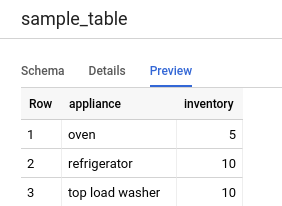管理資料表資料
本文件說明如何透過 BigQuery 管理資料表資料。您可以透過以下方法使用 BigQuery 資料表資料:
- 將資料載入資料表
- 附加或覆寫資料表資料
- 瀏覽 (或預覽) 資料表資料
- 查詢資料表資料
- 使用資料操縱語言 (DML) 修改資料表資料
- 複製資料表資料
- 匯出資料表資料
如需管理資料表結構定義的相關資訊,請參閱修改資料表結構定義一文。
事前準備
將具備必要權限的角色授予需要執行本文中各項工作的使用者。執行工作所需的權限 (如有) 會列在工作的「必要權限」部分。
將資料載入至資料表
您可以在建立資料表時載入資料,或是先建立空白的資料表,之後再載入資料。載入資料時,您可以使用結構定義自動偵測功能找出支援的資料格式,也可以指定結構定義。
如要深入瞭解如何載入資料,請參閱說明文件以瞭解來源資料的格式與位置:
如要深入瞭解如何從 Cloud Storage 載入資料,請參閱:
如要進一步瞭解如何從本機來源載入資料,請參閱從本機檔案載入資料。
附加與覆寫資料表資料
您可以使用載入或查詢作業覆寫資料表資料。您可以藉由執行載入附加作業或將查詢結果附加至資料表,將其他資料附加到現有資料表。
如需在載入資料時附加或覆寫至資料表的詳細資訊,請參閱您的來源資料格式適用的說明文件。
- 將 Avro 資料附加或覆寫至資料表
- 將 CSV 資料附加或覆寫至資料表
- 將 JSON 資料附加或覆寫至資料表
- 將 Parquet 資料附加或覆寫至資料表
- 將 ORC 資料附加或覆寫至資料表
- 將 Datastore 資料附加或覆寫至資料表
如要使用查詢結果來附加或覆寫至資料表,請指定目的地資料表,並將寫入配置設為下列其中一項:
- Append to table (附加到資料表中):將查詢結果附加至現有資料表。
- [Overwrite table] (覆寫資料表):使用查詢結果覆寫名稱相同的現有資料表。
您可以使用下列查詢,將一個資料表的記錄附加到另一個資料表:
INSERT INTO <projectID>.<datasetID>.<table1> ( <column2>, <column3>) (SELECT * FROM <projectID>.<datasetID>.<table2>)
如需使用查詢結果來附加或覆寫資料的詳細資訊,請參閱寫入查詢結果一文。
瀏覽資料表中的資料
您可以透過下列方式瀏覽或讀取資料表中的資料:
- 使用 Google Cloud 控制台
- 使用 bq 指令列工具的
bq head指令 - 呼叫
tabledata.listAPI 方法 - 使用用戶端程式庫
所需權限
如要讀取資料表和分區資料,您需要 bigquery.tables.getData 身分與存取權管理 (IAM) 權限。
下列每個預先定義的 IAM 角色都包含瀏覽資料表和分割區資料所需的權限:
roles/bigquery.dataViewerroles/bigquery.dataEditorroles/bigquery.dataOwnerroles/bigquery.admin
如果您擁有 bigquery.datasets.create 權限,即可瀏覽所建立資料集中的資料表和分區資料。
如要進一步瞭解 BigQuery 中的 IAM 角色和權限,請參閱預先定義的角色與權限一文。
瀏覽資料表中的資料
如何瀏覽資料表中的資料:
控制台
在 Google Cloud 控制台開啟「BigQuery」頁面。
在「Explorer」面板中展開專案並選取資料集。
按一下清單中的資料表。
按一下「詳細資料」,並記下「列數」中的值。使用 bq 指令列工具或 API 時,您可能需要這個值來控管結果的起點。
按一下 [Preview] (預覽)。畫面上會顯示一組資料範例。

指令列
發出 bq head 指令並搭配使用 --max_rows 旗標,即可列出特定資料表列數的所有資料欄。如未指定 --max_rows,則預設值為 100。
如要瀏覽資料表中的資料欄子集 (包括巢狀和重複的資料欄),請使用 --selected_fields 旗標並以逗號分隔的清單形式輸入資料欄。
如要指定顯示資料表中的資料前要略過的列數,請使用 --start_row=integer 旗標 (或 -s 捷徑)。預設值為 0。您可以使用 bq show 指令擷取資料表資訊,以擷取資料表中的列數。
如果您要瀏覽的資料表位於非預設專案中,請使用下列格式將專案 ID 新增至指令:project_id:dataset.table。
bq head \ --max_rows integer1 \ --start_row integer2 \ --selected_fields "columns" \ project_id:dataset.table
其中:
- integer1 是要顯示的列數。
- integer2 是顯示資料前略過的列數。
- columns 是以逗號分隔的資料欄清單。
- project_id 是您的專案 ID。
- dataset 是包含此資料表的資料集名稱。
- table 是要瀏覽的資料表名稱。
範例:
輸入下列指令,列出 mydataset.mytable 中前 10 列的所有資料欄。mydataset 在您的預設專案中。
bq head --max_rows=10 mydataset.mytable
輸入下列指令,列出 mydataset.mytable 中前 100 列的所有資料欄。mydataset 在 myotherproject 中,而不是您的預設專案中。
bq head myotherproject:mydataset.mytable
輸入下列指令,只顯示 mydataset.mytable 中的 field1 和 field2。這個指令使用 --start_row 旗標直接跳到第 100 列。mydataset.mytable 在您的預設專案中。
bq head --start_row 100 --selected_fields "field1,field2" mydataset.mytable
因為 bq head 指令不會建立查詢工作,所以 bq head 指令不會出現在您的查詢記錄中,也不會產生費用。
API
呼叫 tabledata.list 即可瀏覽整份資料表的資料。在 tableId 參數中指定資料表名稱。
設定以下選用參數控管輸出:
maxResults:要傳回的結果數上限selectedFields:傳回以逗號分隔的資料欄清單。如果未指定,則會傳回所有資料欄startIndex:讀取的起始列,索引從零開始。
傳回的值會以 JSON 物件包裝,而您必須剖析這個物件,如 tabledata.list 參考說明文件所述。
C#
在試行這個範例之前,請先按照 BigQuery 快速入門導覽課程:使用用戶端程式庫中的 C# 設定說明進行操作。詳情請參閱 BigQuery C# API 參考說明文件。
如要向 BigQuery 進行驗證,請設定應用程式預設憑證。 詳情請參閱「設定用戶端程式庫的驗證機制」。
Go
在試行這個範例之前,請先按照 BigQuery 快速入門導覽課程:使用用戶端程式庫中的 Go 設定說明進行操作。詳情請參閱 BigQuery Go API 參考說明文件。
如要向 BigQuery 進行驗證,請設定應用程式預設憑證。 詳情請參閱「設定用戶端程式庫的驗證機制」。
根據預設,Go 專用的 Cloud 用戶端程式庫會自動進行分頁,因此您無須自行實作分頁程序,例如:
Java
在試行這個範例之前,請先按照 BigQuery 快速入門導覽課程:使用用戶端程式庫中的 Java 設定說明進行操作。詳情請參閱 BigQuery Java API 參考說明文件。
如要向 BigQuery 進行驗證,請設定應用程式預設憑證。 詳情請參閱「設定用戶端程式庫的驗證機制」。
Node.js
在試行這個範例之前,請先按照 BigQuery 快速入門導覽課程:使用用戶端程式庫中的 Node.js 設定說明進行操作。詳情請參閱 BigQuery Node.js API 參考說明文件。
如要向 BigQuery 進行驗證,請設定應用程式預設憑證。 詳情請參閱「設定用戶端程式庫的驗證機制」。
根據預設,Node.js 適用的 Cloud 用戶端程式庫會自動進行分頁,因此您無須自行實作分頁程序,例如:
PHP
在試行這個範例之前,請先按照 BigQuery 快速入門導覽課程:使用用戶端程式庫中的 PHP 設定說明進行操作。詳情請參閱 BigQuery PHP API 參考說明文件。
如要向 BigQuery 進行驗證,請設定應用程式預設憑證。 詳情請參閱「設定用戶端程式庫的驗證機制」。
PHP 適用的 Cloud 用戶端程式庫會透過產生器函式 rows 在疊代作業期間擷取下一頁的結果,藉此自動進行分頁。
Python
在試行這個範例之前,請先按照 BigQuery 快速入門導覽課程:使用用戶端程式庫中的 Python 設定說明進行操作。詳情請參閱 BigQuery Python API 參考說明文件。
如要向 BigQuery 進行驗證,請設定應用程式預設憑證。 詳情請參閱「設定用戶端程式庫的驗證機制」。
Ruby
在試行這個範例之前,請先按照 BigQuery 快速入門導覽課程:使用用戶端程式庫中的 Ruby 設定說明進行操作。詳情請參閱 BigQuery Ruby API 參考說明文件。
如要向 BigQuery 進行驗證,請設定應用程式預設憑證。 詳情請參閱「設定用戶端程式庫的驗證機制」。
Ruby 適用的 Cloud 用戶端程式庫會透過 Table#data 和 Data#next 自動進行分頁。
查詢資料表資料
您可以使用下列其中一種查詢工作類型查詢 BigQuery 資料:
互動式查詢作業。根據預設,BigQuery 會以互動式查詢工作執行查詢,這類工作會盡快開始執行。
批次查詢工作。批次查詢的優先順序低於互動式查詢。如果專案或預訂項目已用盡所有可用的運算資源,批次查詢就更有可能排入佇列,並留在佇列中。批次查詢開始執行後,運作方式與互動式查詢相同。詳情請參閱「查詢佇列」。
持續查詢工作。 這些工作會持續執行查詢,讓您即時分析 BigQuery 中的輸入資料,然後將結果寫入 BigQuery 資料表,或將結果匯出至 Bigtable 或 Pub/Sub。您可以使用這項功能執行時間敏感型工作,例如建立洞察資料並立即採取行動、套用即時機器學習 (ML) 推論,以及建構事件驅動的資料管道。
您可以使用下列方法執行查詢工作:
- 在Google Cloud 控制台中編寫及執行查詢。
- 在 bq 指令列工具中執行
bq query指令。 - 透過程式呼叫 BigQuery REST API 中的
jobs.query或jobs.insert方法。 - 使用 BigQuery 用戶端程式庫。
關於如何查詢 BigQuery 資料表的詳情,請參閱查詢 BigQuery 資料簡介。
除了查詢儲存在 BigQuery 表格中的資料外,您還可以查詢儲存在外部的資料。詳情請參閱外部資料來源簡介。
修改資料表資料
您可以使用 SQL 中的資料操縱語言 (DML) 陳述式,修改資料表中的資料。您可以使用 DML 陳述式更新、合併、插入及刪除資料表中的資料列。如需各類型 DML 陳述式的語法參考資料和範例,請參閱「GoogleSQL 中的資料操縱語言陳述式」。
舊版 SQL 方言不支援 DML 陳述式。若要使用舊版 SQL 更新或刪除資料,您必須先刪除資料表,然後以新資料重新建立該資料表。另外,您也可以撰寫查詢來修改資料,並將查詢結果寫入新的目標資料表。
複製資料表資料
您可以透過以下方式複製資料表:
- 使用 Google Cloud 控制台
- 使用 bq 指令列工具的
bq cp指令 - 呼叫
jobs.insertAPI 方法並設定複製工作 - 使用用戶端程式庫
如要深入瞭解複製資料表,請參閱複製資料表一文。
匯出資料表資料
您可以將資料表資料匯出至 Cloud Storage 值區,格式為 CSV、JSON、Avro 或 Parquet (搶先版)。系統不支援將資料匯出至本機電腦,但您可使用 Google Cloud 控制台下載和儲存查詢結果。
詳情請參閱匯出資料表資料一文。
表格安全性
如要控管 BigQuery 資料表的存取權,請參閱「使用 IAM 控管資源存取權」。
後續步驟
- 如要深入瞭解如何載入資料,請參閱載入資料簡介。
- 如要深入瞭解如何查詢資料,請參閱查詢 BigQuery 資料簡介。
- 如要深入瞭解如何修改資料表結構定義,請參閱修改資料表結構定義。
- 關於如何建立及使用資料表,請參閱建立及使用資料表一文。
- 關於如何管理資料表,請參閱管理資料表一文。

